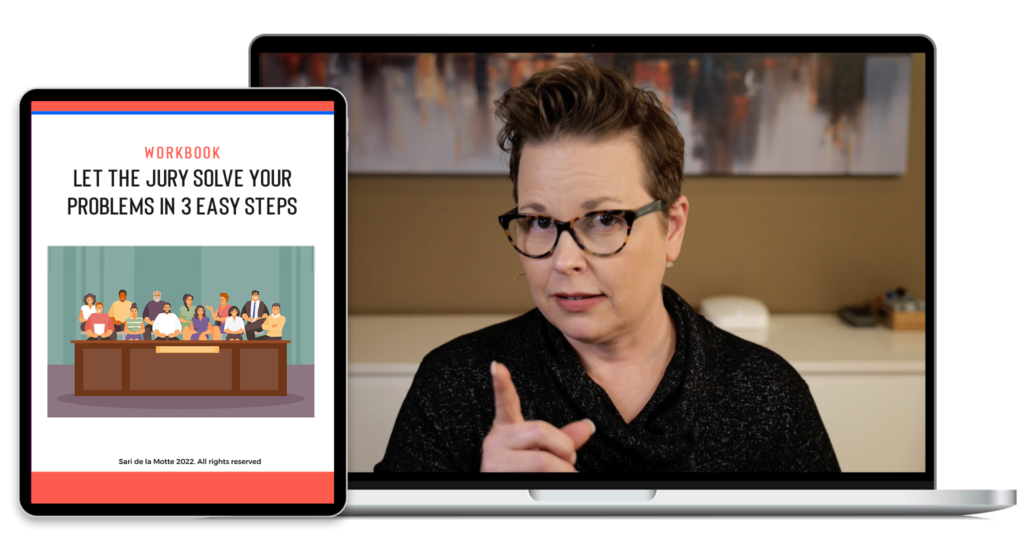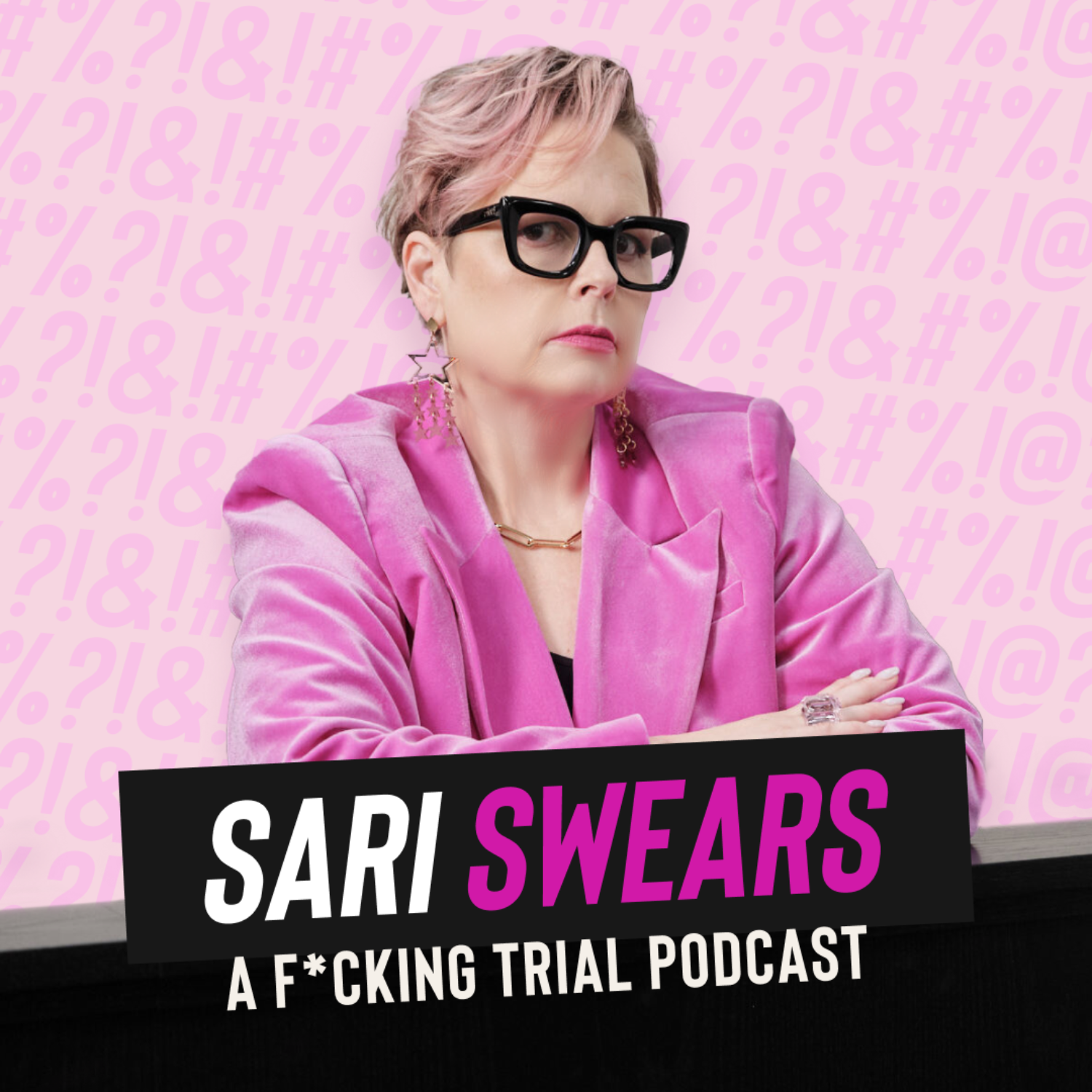Jurors DON’T need a show.
They NEED a leader.
In this week’s episode, I’m handing you the entire back-of-house blueprint, so you can finally STOP faking confidence and START generating real influence — WITHOUT THE BURNOUT.
Ditch the fear-based prep.
Drop the performance act.
And lead the hell out of your next trial.
🎧 Hit play. Your real influence starts BEFORE the opening.
Love,
Sari 💖
➡️FREE FB GROUP FOR PLAINTIFF & CRIMINAL DEFENSE ATTORNEYS
“Circumstances never create feelings; thoughts do. When you lose at trial, the fact of losing is neutral. It’s your interpretation that makes you feel despair, anxiety, or defeat. By changing your thought from “I suck” to “My job is to fight,” you transform your feeling into energy—pride, excitement, determination—and that drives bold actions. You begin to take risks, play big, and ultimately achieve better results. Master your thoughts, and you master your fate.”
sari de la motte
EPISODE TRANSCRIPTION
Hello, hello. Okay, so in the old method we have four steps: introduce safety, invite engagement, inspire commitment, and incite action. Let me talk about how we are still going to use that, but how we have changed a couple of things. Basically, if you have ever worked in a restaurant—Kevin did; he was a chef for years—many of you may have been servers at some point. We have “front of the house” and “back of the house.” Front of the house includes the servers and the host; back of the house includes the cooks and dishwashers.
What I am trying to tell you is that the method you see in the From Hostage to Hero book is the front-of-the-house method: what you do at trial. I am going to show you the back-of-the-house method today—the method we focus on here in the playground—so that we can perform the front-of-house work at trial.
I will run through the original steps because we have some new people here. In the “introduce safety” portion, right when you first meet the jurors, you must establish what you will say, do, and read to confirm that what you are doing is working.
What you say is the designed alliance. Remember, the designed alliance is the carrot you dangle because at the beginning the only thing jurors want is not to be there. You must give them what they want—or at least a way to get what they want—and then they are motivated.
Many of you say, “Jurors will not talk to me.” I say, “Yes, because you have not offered them anything they want.” The designed alliance is exactly that.
You can re-read it in the book or find it on the membership portal, but the gist is this: you tell jurors they probably believe jury selection means they must sit here, we will choose them whether they like it or not, and then— You can turn all that off, Kevin, if you want—the heater, I mean—thanks. Then you say, “We will not do it that way. Instead, we would like to have a conversation with you, and based on that conversation you will tell us whether you want to be here. Who would like to have that conversation?” Jurors think, “Yes, I’d like to have that conversation because then I can tell you I don’t want to be here,” which rarely happens.
We add two caveats. First: “I cannot discuss facts or evidence, only principles. That can be frustrating because you will want details, and I cannot give them. Are you still willing?” I do that first caveat for two reasons. One, it is the design in the alliance: later, when conversation gets juicy, jurors will want details, and if you have already warned them, they understand why you cannot answer. Most of you wait until you are stuck, reply, “I cannot talk about that,” and jurors feel stupid. We do not want jurors to feel stupid.
Two, it gets them to agree with us again. Every “yes” creates rapport.
Second caveat: “If you tell me at the end you do not want to serve, I have limited power. I will do what I can, but the other side and the judge also decide. Knowing I do not have total control, are you still willing?” They always say yes. That is the designed alliance.
While delivering it, you must breathe well—slow and low. Listeners take their breathing cues from the speaker. Jurors are already in fight-or-flight because they are in a brand-new situation. If you bring nervous energy, everyone stays tense and nobody hears anything. You must learn to breathe calmly under stress. Second, use authoritative body language and voice: head still and straight, palms down, weight evenly on both feet, toes forward, voice curling down.
Hostages need a leader: “Here’s how this works.” You all do the opposite; you walk in and ask, “What bumper stickers do you have on your car?” Jurors think, “Is this a first date?” Your job is leadership.
What we are reading is juror breathing. You know it is working when the room calms and jurors answer comfortably. How do you read breathing? You sense the room. Walk into any room after two people have been fighting: the tension is in the air. When the air feels less tense and you do not have to struggle to keep your own breath low, jurors are breathing. When they answer easily, they are breathing.
Second step in the original method—still used—is “invite engagement.” Jurors are now safe: breathing, listening, ready. Again, you ask, “Why won’t they talk to me?” Because you have not prepared them to talk.
Safety must precede engagement. I use a dating analogy—though you are not dating jurors, so stop with hobby questions. After safety, you present your issue-oriented voir dire (IOV). You will build that in the playground: taking all the issues in your case, flipping them, and letting jurors solve your problems.
During IOV you mainly listen. You must use approachable non-verbals: slight head tilt or nod, voice curling up, palms up, weight shifted to one leg, toes splayed. If you stand rigid with palms down, jurors will not answer. You will learn that here. You read whether conversations are resonant—whether jurors give you your principles.
Third is “inspire commitment”: opening statement. You will learn the nine-part template and presentation skills: frozen-hand gesture—when you pause, your hands freeze; only move when you speak. That seizes attention. Storytelling, pacing, vocal variety. During opening you read permission—real receptivity—by breathing and body cues.
Fourth is “incite action”: closing. You will learn our new closing template. In closing you use big leadership non-verbals. Think of sending troops into battle: you do not go with them, but you must inspire them. After closing, read the verdict form. (There are deeper dynamics, but first master the basics.)
Those four steps are the Hero’s Journey—front-of-house work. They depend on back-of-house preparation: a new three-cornerstone framework.
Create compelling content.
Command the courtroom.
Claim your freedom.
Before any cornerstone you must change your mind about jurors. They are not the enemy; they stand on the side of right. If you see them as hostile, you play small, avoid risks, and lose. We use the CTFAR model—Circumstance, Thought, Feeling, Action, Result—to rewire thinking.
Example: Circumstance—“I lost at trial.”
Thought—“I suck.”
Feeling—despair.
Action—over-prepare, settle, play small.
Result—no growth.
Change the thought to “My job is to fight,” feel energized, take bold actions, and achieve better results. Circumstances never create feelings; thoughts do. So first: change your mind.
Cornerstone 1: Create compelling content
Your job is to compel jurors to act. Content must be about them. Main components you will master here:
the Designed Alliance
Issue-Oriented Voir Dire
the Nine-Part Opening Template
the Closing Template
Pick one to master first. Voir dire asks questions; opening answers them—in the jurors’ own words—so they own the story. Confirmation bias then drives them to stay with their initial conclusion.
Cornerstone 2: Command the courtroom
Content alone is not enough; delivery matters. Develop three skills:
Facilitation. Guide juror conversation so they interact with each other. Giving away power proves you have power.
Presentation. Master stage skills—posture, gesture, pause, voice, storytelling.
Motivation. Inspire jurors to follow you; leadership requires followers.
Choose one skill to master this year. Remember: when words and body conflict, jurors believe the body.
Cornerstone 3: Claim your freedom
Three mindset shifts support everything:
Let go of winning. Attachment creates crushing stress. Focus on fighting well—something you control.
Conquer your fear. Big results require big risks; fear keeps you in Level 1 listening and small actions.
Own your greatness. Decide you are a great trial lawyer now. Behave accordingly; results follow.
We used CTFAR live: “I must win because everyone depends on me” produces stress, overwork, second-guessing, and poor performance. Change to “My job is to fight,” feel excited, take bold actions, and win more.
Female Speaker: Sorry to interrupt—it looks like some of the text is cut off on your screen. Is that just me?
Sari de la Motte: Kevin sees it too. I’ll switch screens. This is why I prefer flip charts—they’re simpler. [switches display]
We completed several live CTFAR examples, showing how new thoughts change feelings and outcomes. We practiced replacing “I must win” with empowering alternatives, noticed lighter emotions, and listed courageous actions.
Sari de la Motte: Let’s recap. Back-of-house work—changing your mind, creating compelling content, commanding the courtroom, claiming your freedom—enables the front-of-house Hero’s Journey at trial. Decide which content element and which command skill you will master first. Start rewiring your thoughts about jurors and winning. You are already great. Choose to be that great trial lawyer now, act accordingly, and the verdicts will come.
I love all of you, my children. Go, learn, and apply these lessons. Talk soon.


Free Training
3 pOWERFUL STRATEGIES TO HELP YOU READ A JUROR'S MIND
Let the Jury Solve Your Problems in 3 Easy Steps
Join me for a free training to understand what the jury is thinking so you have the confidence to trust them - and yourself - in the courtroom.
Use the H2H Funnel Method so that jurors tell YOU the principles of the case instead of you telling THEM.

Subscribe to the Podcast
Tune in weekly as Sari shares tips that will help you up your game at trial, connect with jurors, and build confidence in your abilities so that you’ll never worry about winning again.
Sign up for trial tips, mindset shifts, and whatever else is on Sari’s brilliant fucking mind.




